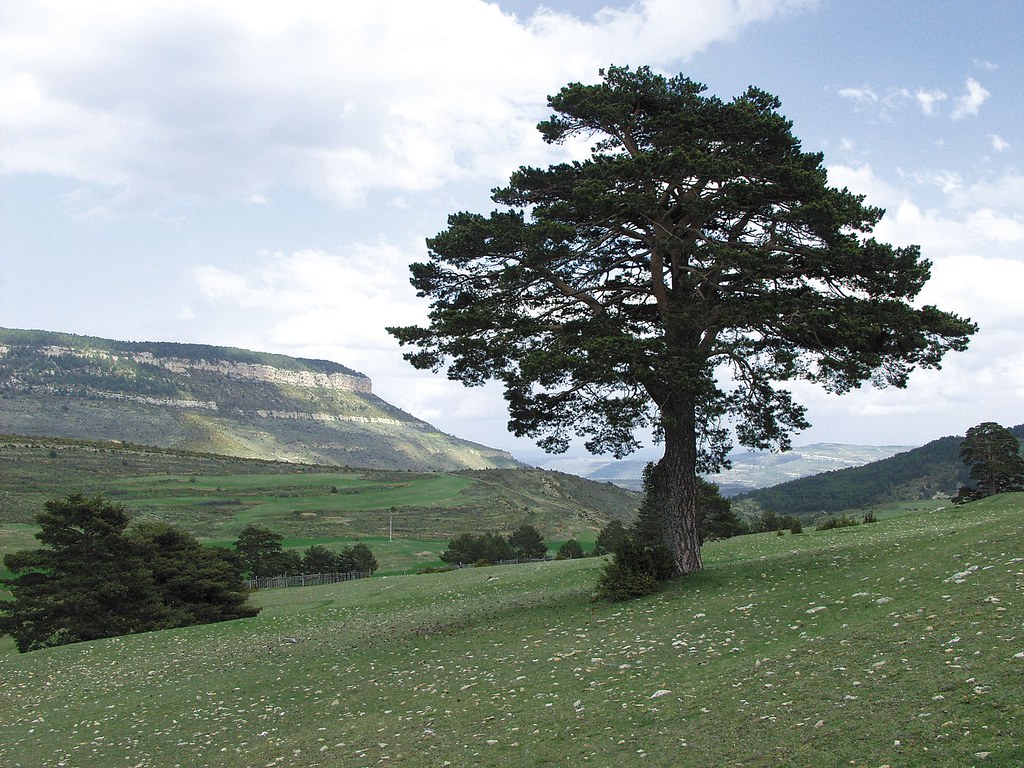Nestled in the
eastern Iberian mountain range, Cantavieja has a Mediterranean climate tempered
by its altitude. The terrain consists of rocky cliffs, plains and deep canyons.
Its varied
topographical features include raised mesas with tilted strata or flat-topped
mountains, (Muela Mochén), narrow river valleys (River Cantavieja), and damp clay
hillsides (Tarayuela and Cuarto Pelado).
 Its location
in the Mediterranean bioclimatic region, specifically in the Maestrazgo area of
the Castellano-Maestrazgo-Manchega region makes it a popular destination for
nature lovers.
Its location
in the Mediterranean bioclimatic region, specifically in the Maestrazgo area of
the Castellano-Maestrazgo-Manchega region makes it a popular destination for
nature lovers.
A large part
of Cantavieja’s municipal district falls within SCIs (Site of Community
Importance) and SPAs (Special Protection Area for birds). The SCIs and SPAs
found in the municipality are:
SCI
Muelas y Estrechos del Río Guadalope.
SCI Rambla de las Truchas.
SCI Maestrazgo y Sierra de Gúdar.
SPA Río Guadalope-Maestrazgo
From
Cantavieja there are plenty of short walks where you can find the local fauna
and flora in all its glory.
El Rebollar
and the Natural spring of Faldrija Footpath (PR-69)
 This footpath takes
the visitor to the picnic area of El Rebollar and the natural spring of
Faldrija, a recreational area in the middle of the countryside. El Rebollar is
a transition zone where the forests of Corsican pines (Pinus nigra) meet the uppemost limit of oodlands of holm oaks (Quercus ilex) and Portuguese oaks (Quercus faginea). In this enclave these
species battle it out to colonise the space, influenced by the altitude, the
orientation of the slope, and the underlying rock. It is an area of great
environmental value frequented by species such as wild boar (Sus scrofa) and roe deer (Capreolus
capreolus); you might even come
across the tracks of a badger (Meles meles) or a stone marten (Martes
foina).
This footpath takes
the visitor to the picnic area of El Rebollar and the natural spring of
Faldrija, a recreational area in the middle of the countryside. El Rebollar is
a transition zone where the forests of Corsican pines (Pinus nigra) meet the uppemost limit of oodlands of holm oaks (Quercus ilex) and Portuguese oaks (Quercus faginea). In this enclave these
species battle it out to colonise the space, influenced by the altitude, the
orientation of the slope, and the underlying rock. It is an area of great
environmental value frequented by species such as wild boar (Sus scrofa) and roe deer (Capreolus
capreolus); you might even come
across the tracks of a badger (Meles meles) or a stone marten (Martes
foina).
Circular route
to the River Cantavieja (GR-8, PR-70)
This circular
route takes in the River Cantavieja, where you can admire the riverside woods
of poplars (Populus nigra), willows (Salix alba), ash (Fraxinus angustifolia), elms (Ulmus
minor) and crack willow (Salix
fragilis) and see birds such as the golden oriole (Oriolus oriolus) that nest and raise their young there.
 Along the
river you might see signs of otters (Lutra
lutra), or watch grey wagtails (Motacilla
cinerea) and white wagtails (Motacilla
alba) playing by the water. Sightings of dippers (Cinclus cinclus) have also been recorded.
Along the
river you might see signs of otters (Lutra
lutra), or watch grey wagtails (Motacilla
cinerea) and white wagtails (Motacilla
alba) playing by the water. Sightings of dippers (Cinclus cinclus) have also been recorded.
Keeping watch
from the rocky cliffs is the majestic species, the ibex or mountain goat (Capra pyrenaica hispánica).
Flying overhead you can see Griffon vulture (Gyps fulvus), golden eagle (Aquila chrysaetos), Egyptian vulture (Neophron percnopterus), peregrine falcon
(Falco peregrinus), common buzzard (Buteo buteo), booted eagle (Hieraaetus pennatus), European
short-toed snake eagle (Circaetus
gallicus) or perhaps a disorientated kestrel (Falco tinnunculus).
The Tarayuela Cross
Footpath (GR-8)
Other birds to
be seen in this area include the short-toed snake eagle (Circaetus
gallicus) , crow (Corvus
corone), great tit (Parus major),
blue tit (Cyanistes caeruleus),
common chaffinch (Fringilla coelebs)
or the magnificent hoopoe (Upupa epops).

No hay comentarios:
Publicar un comentario